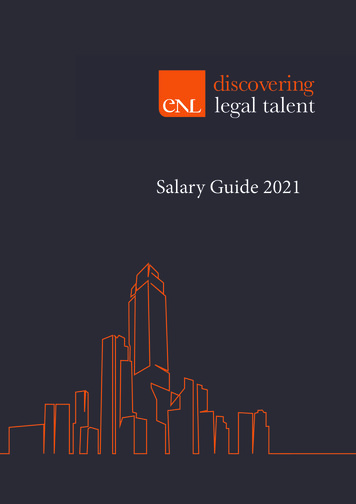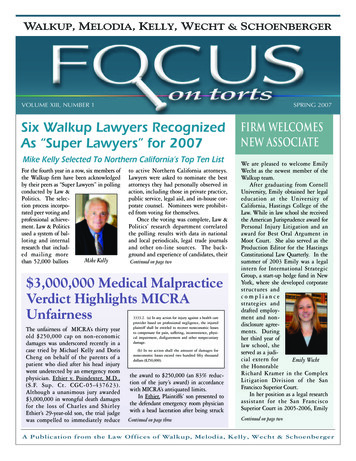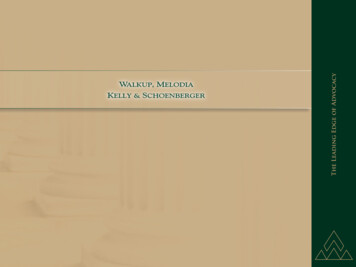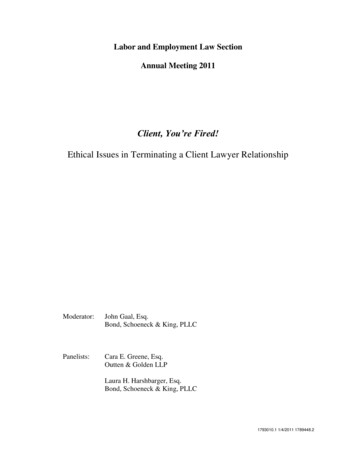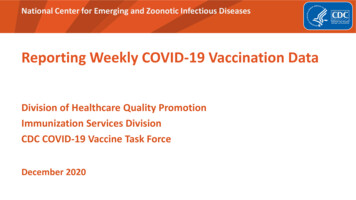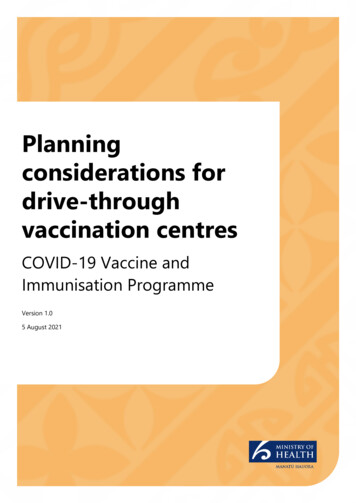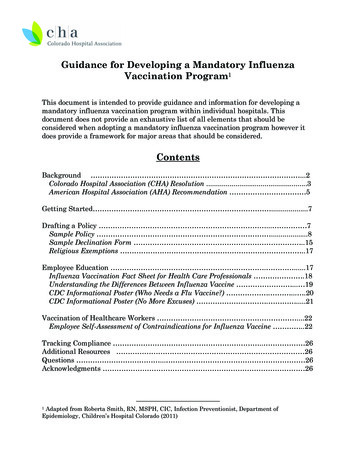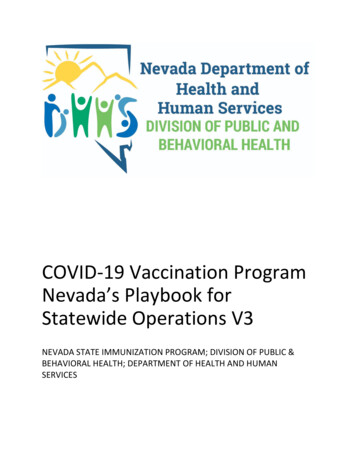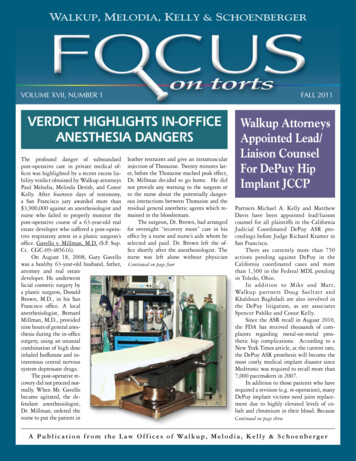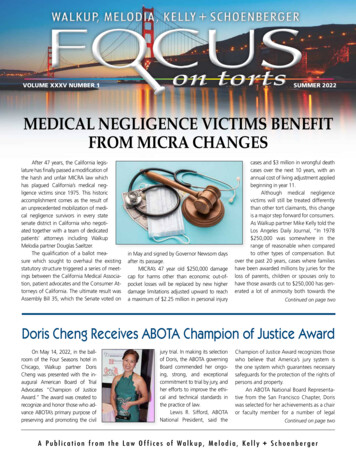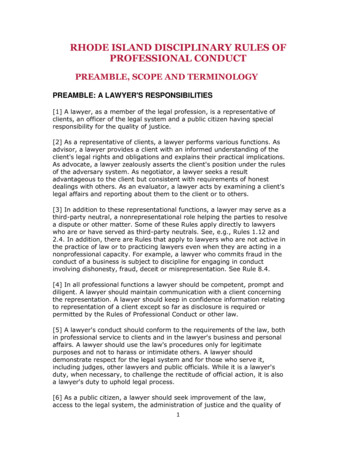
Transcription
VOLUMENUMBER11VOLUME XXXIVXXII, NUMBERFollowing the North Bay and Paradise/Butte County wildfires in 2017 and 2018,PG&E Corporation filed for Chapter 11bankruptcy protection. Our Wildfire Litigation team, headed by partners MichaelA. Kelly and Khaldoun Baghdadi, have ledthe fight to hold PG&E responsible for thedamage it caused since October 9, 2017.They were lead and liaison counsel respectively in the JCCP Coordinated Litigationthat began in November 2017, and laterserved as counsel to members of the TortClaim Creditors Committee in the bankruptcy. They presently serve on the TrustOversight Committee established at thetime of PG&E’s exit from bankruptcy.PG&E’s Plan of Reorganization underChapter 11 was confirmed by the Bankruptcy Court on June 20, 2020. The FireVictim Trust is tasked with evaluating,administering, processing and resolvingmore than 70,000 claims under the direc-tion of the Trustee, the Honorable John K.Trotter, Jr. (Ret.).The Claims Resolution Procedures outline seven types of claims that fire victimsmay submit: (1) Real Property, (2) PersonalProperty, (3) Personal Income Loss, (4) Business Loss, (5) Other Out-of-Pocket Expenses,(6) Wrongful Death and Personal Injury, and(7) Emotional Distress.WINTERSUMMER20212018The Trust is funded 50% through cashand 50% through shares in the reorganized PG&E. This fact has resulted in someuncertainty as to when full funding will beachieved, but it will not prevent the Trustfrom beginning to pay first installments onapproved and accepted claim awards beginning on and after March 15, 2021. TrusteeJohn Trotter has said that it is his hope thatvictims will get everything they’re owed. Currently managing 6 billion in cash, the Trustee and his advisors have developed a careful‘sell-down plan’ waiting for the share priceto rise and stabilize before selling shares.The payment process has required analyzing tens of thousands of claim questionnaires,with less than 50% of claims having been verified and completed as of February 15. Nonetheless, on February 15, the Trust began notifying victims with completed deficiency-freequestionnaires how much their claims wereContinued on page twoWalkup Lawyer Volunteers In Vaccination EffortDr. Christian Jagusch,Walkup’s Medical Negligence Counsel, has beentreating patients with COVID-19 since March 2020using telemedicine across11 states. Now with therollout of the COVID-19vaccine, Dr. Jagusch hasjoined the Napa CountyMedical Reserve Corp. Aspart of this volunteer team,he will administer vaccinesto the community in thenationwide effort to put anend to the pandemic.As we go to press, twovaccines are approved for usein the U.S. They are manufactured by Pfizer and Moderna.Unlike other vaccines, these vaccines use aunique method for inserting the viral RNAmessenger into the body’s cells to producean immune response to the Spike protein, aspecific part of the Coronavirus. Neither vaccine is a live virus and neither can cause disease. Though a novel approach to vaccines,this therapy has been studied since 2013 forother disease processes and is consideredContinued on page threeA Publication from the Law Offices of Walkup, Melodia, Kelly Schoenberger
the health and lives of all of the Tenderloin’sresidents. What has long been suffered in theTenderloin has become insufferable. The conditions now prevailing in the Tenderloin constitute a violation of the fundamental civil rightsof those residing and working there.The lawsuit sought no monetary recovery,focusing exclusively on injunctive relief, mean-ing that the Tenderloin plaintiffs demandedonly that the City address the deplorable conditions in their neighborhood.The suit was assigned to United StatesDistrict Court Judge Jon S. Tigar, who quicklyissued an order requiring the City to immediately make an appearance in the case. TheCity and the Tenderloin plaintiffs then entered into settlement negotiations, presidedover by Magistrate Judge Jacqueline ScottCorley. Following extensive and intense negotiations, the parties reached a settlement,set forth in a “stipulated injunction” whichJudge Tigar entered on June 30, 2020, lessthan eight weeks after the lawsuit was filed.Under the terms of the settlement, theCity agreed to reduce the number of tents inthe neighborhood and to “make all reasonable efforts to achieve the shared goal ofpermanently reducing the number of tents,along with all other encamping materialsand related personal property, to zero.”David Faigman, Chancellor and Dean atUC Hastings, commented that “the team ofMike Kelly, Rich Schoenberger and Matt Daviswere spectacular. They brought enormous intelligence and extraordinary expertise to whatwas a delicate legal and political matter. Theywere a constant delight to work with and evenduring the most tense moments they broughtperspective, calm professionalism, and blessedly, a sense of humor to our meetings. Wewere incredibly fortunate to have this team asour champions in this litigation.”Monitoring and enforcement of theinjunction continues as the City works tosolve ongoing drug sale issues which havepersisted notwithstanding resolution of thesidewalk encampments. Our team remainsinvolved, continuing their quest to improvethe quality of life for all who live or work inthe Tenderloin.receiving the same flat percentage.The Trust kick-started the payment processin the fall of 2020 by creating a preliminary compensation program to give survivors as much as 25,000 before their full claims were processed.At the time that plan was initiated with theTrust, administrators said they were not awareof any other bankruptcy case that had imple-mented such an early payment program.While the journey for victims is farfrom over, there is finally a glimmer oflight at the end of the tunnel. Our WildfireLitigation team has stayed focused on therights of our clients since the first of thesefires ignited in the fall of 2017. We will notrest until each of our clients has receivedthe maximum amount due them under theTrust’s rules and procedures.Firm Prosecutes SuccessfulTenderloin Quality of Life ActionFirm partners Michael A. Kelly, Richard H. Schoenberger and Matthew D. Davisacted as co-lead counsel in a Federal DistrictCourt action that forced the City and County of San Francisco to address the massiveproliferation of tents and encampments onthe sidewalks and streets of the City’s Tenderloin district. The positive impact suit wasfiled on behalf of UC Hastings College of theLaw (which is situated in the Tenderloin) andloin’s sidewalks became literally impassabledue to the erection of more than 400 tents andmakeshift encampments blocking sidewalksand doorways. The suit alleged:The Tenderloin, always a community oftolerance and compassion, is now blighted;its sidewalks are unsanitary, unsafe, and often impassable. Open-air drug sales and othercriminal activity, plus crowds of drug users andsidewalk-blocking tents, pervade and threatenHomeless camp on Eddy and Taylor in San Francisco’s Tenderloin on April 3, 2020(Photo: Jason Doiy/ALM)five other Tenderloin individuals and businesses. Kelly, Schoenberger and Davis are allHastings graduates. The firm performed thework pro bono.The complaint in Hastings College of theLaw, et al. v. City and County of San Franciscowas filed in the United States District Court ofNorthern California, after many of the Tender-Continued from page onevalued at, with the intention of rolling outpartial claim payments beginning March 15,2021 for accepted claims where the victim forgoes further appeals or litigation. The pro rataamount to be paid has not been determined aswe go to press. According to bankruptcy law,all victims must be treated the same with eachtwo
DANGEROUS CROSSWALK LEADS TO 11,100,000 SETTLEMENTRichard H. Schoenberger, Douglas S.Saeltzer and Jeffrey A. Clause recently obtained an 11,100,000 mediated recoveryon behalf of a 6-year-old boy and two surviving heirs of his deceased grandmotherfollowing a tragic auto versus pedestriancrash. The boy and his grandmother werecrossing the street in a marked crosswalkwhen they were struck by a hit-and-rundriver. The young plaintiff sustained severeorthopedic injuries and a traumatic brain injury. He spent more than 50 days in the hospital. His grandmother sustained fatal bluntforce trauma. She was survived by her twoadult children.The Walkup team argued that the underinsured hit-and-run driver, as well asthe city which maintained the crosswalk,were both substantial factors in bringingabout the tragedy.As to the public entity which paid 11,000,000 of the settlement, Rich,Doug and Jeff demonstrated that themarked crosswalk located at a multi-lane,high speed, high traffic volume and uncontrolled intersection, negligently created a false sense of security which allowedpedestrians to feel safe in the absence ofstop signs or stop lights. Several monthsbefore the collision the City had conducted a pedestrian traffic study of the intersection and confirmed that the markedcrosswalk was potentially dangerous andactually increased the pedestrian crashrisk. As a result, the City undertook toremove the marked crosswalk by attempting to grind out the painted markings. Butthe removal was negligently carried out –with the crosswalk remaining visible in theform of distinct grind marks and remnantsof the white thermoplastic. Making matters worse, the City removed advanced pe-destrian crossing warning signs as part ofthe removal project in violation of its ownDesign and Procedures Manual. Thus, notonly did the marked crosswalk arguablyremain visible, but necessary warnings todrivers were eliminated.Relying on a published federal studyand the municipality’s own Pedestrian Crossing Guidelines, the Walkup team successfullysurvived summary judgment arguing that thedefendant took an intersection that it knewwas dangerous, and effectively made it evenmore dangerous. Had the City completelyremoved the crosswalk and left the warningsigns in place, the young boy would not havebeen injured and his grandmother would stillbe alive today.The case resolved at mediation shortly before trial. It is believed to be one of the largest pretrial dangerous crosswalk settlements inNorthern California history.Walkup Lawyer Volunteers In Vaccination EffortContinued from page onesafe with only rare serious side effects. Current data reports approximately 95% effectiveness after the two-injection series. Thismeans that the vaccinated person possessesexcellent protection from getting COVID-19disease. Preliminary data suggests that thesevaccines may also be effective in prevent-ing the transmission of COVID-19. Untilmore data on the transmission of disease isreviewed, it remains critical that even vaccinated people continue practicing physicaldistancing, diligent handwashing, and maskprecautions.Most experts agree that once 60-70%threeof the population has either been vaccinatedor has natural immunity from contracting thedisease, COVID-19 can be controlled or eveneradicated. This principle is based on so-calledherd immunity. Together with continued safetyprecautions and vaccinations, we can reach theend of this pandemic.
Mike Kelly was selected to the LawDragon 500 Hall of Fame. Mike was alsohonored to be the top vote-getter amongall Northern California Super Lawyers in theballoting for 2020 and 2021. In the springhe has been invited to present the secondannual Connecticut Trial Lawyers “MichaelKoskoff Memorial Lecture.” The presentationhonors the memory of Mike Koskoff, an iconof the Plaintiffs Bar nationally, who passed in2019 Rich Schoenberger was an invitedpresenter for a NITA Studio 71 nationwidebroadcast focused on jury selection. He alsospoke at a fall roundtable hosted by SFTLAentitled “Plaintiff Attorneys Trial Playbook:Life After People v. Sanchez.” Rich was alsoelected to the Board of Governors of the International Society of Barristers Foundation Matthew Davis was elected to membershipin the San Francisco Chapter of the American Board of Trial Advocates (ABOTA). Matt’selection brings the total number of ABOTAmembers from our firm over the past 60years to 20 – more than twice as many members as any other trial firm in Northern Cali-fornia. Doug Saeltzer was elected to theposition of Vice President of the ConsumerAttorneys of California (CAOC) having previously served as Secretary of the organization.Doug was also appointed Chair of the BarAssociation of San Francisco Judiciary Committee. The committee is charged with evaluating candidates seeking appointment orelection to the San Francisco Superior Court,the Court of Appeal for the FirstAppellate District, the SupremeCourt of California, the NinthCircuit Court of Appeals, and theU.S. District Court for the Northern District of California DorisCheng completed her term asPresident of the San FranciscoChapter of ABOTA, navigatingthe pandemic year via multipleinformational, membership andCLE events via online platforms.She is the sixth member of thefirm to have held this position – a recordunmatched by any other firm. Doris wasalso honored to be appointed Chair of theCalifornia Lawyers Association Task Force forthe Future of the Profession. Finally, she hasagreed to direct a reprise of the hugely suc-cessful “Women in Trial“ skills program forthe Bar Association of San Francisco Spencer Pahlke helped organize a team of 150volunteers to do in excess of 5,000 hours ofwork in the 2020 General and Run-Off Elections Conor Kelly was an invited speakerat the annual Consumer Attorneys of California (CAOC) virtual convention addressingthe issues surrounding litigating personal injury cases against ridesharecompanies Valerie Rosewas elected to the Board ofDirectors of SFTLA and willbe co-chairing its Women’sCaucus this year SaraLeung, wife of associateJoseph Nicholson, recently accepted an associateposition at Bley and Bleyin San Francisco, whereshe continues her familylaw practice Announcingour newest parents, Jade Smith-Williamsand husband Ricky Ramos, who welcomedtheir first born, a son, Kayson Kairo Ramos,on November 23. Arriving at 8 lbs, 15 ozand 22 inches, mom reports “he is growingso fast!”Walkup Civil Justice Fellow For 2020-2021We are proud to introduce the 20202021 Fellow for the Walkup Civil JusticeFellowship Program. KelseyConstantin grew up in Irvine,California and attended UCSanta Barbara where shereceived her B.A. in psychology. After graduation, shemoved up the coast to Oakland and enjoyed Bay Arealiving while exploring different career paths. When shelanded a position as a legalassistant at a personal injuryfirm, it sparked her interestin becoming a lawyer.Kelsey graduated magna cum laude fromUC Hastings in 2020. During her time at Hastings she pursued opportunities in various legal sectors but always maintained her passionfor public interest work. Growing up aroundher mother’s special education classroomand volunteering with special needs childrenthroughout high school instilled a passion in Kelsey forhelping young people whichshe applied in her internshipat East Bay Children’s LawOffices, and as an ExecutiveBoard member of the Hastings Association of Youth Advocates. While in law schoolKelsey externed for the Honorable Ming W. Chin on theCalifornia Supreme Court,interned in the Clean SlateProgram operated by the Alameda Public Defender’s Office, and served asthe Executive Articles Editor for Hastings LawJournal.In her last year of law school, Kelseyworked in the Hastings Individual Reprefoursentation Clinic and represented clientsin a Social Security appeal, and obtaineda criminal conviction dismissal. Her lawschool experiences led Kelsey to apply forthe Civil Justice Fellowship because it offered the opportunity to learn from distinguished litigators while helping clientsthrough critical and difficult points in theirlives. Connecting with people and clientcentered advocacy fighting social injusticesare Kelsey’s main driving forces in her legalcareer. The types of cases that the Walkupteam handles also exemplify the kind of impact on both individuals and systems thatKelsey wants to be a part of.As Kelsey arrived we bid a fond adieu tolast year’s Fellow, Daniel Contreras, who returned to his home state of Texas to completea judicial clerkship in San Antonio at the endof his fellowship year. We wish Daniel continued success in his legal career.
HealthcareIndustryProfits DuringPandemicIn the midst of a pandemic-inducedfloundering economy, Kaiser Permanenteannounced it had achieved 2.2 billion inoperating income in 2020. HCA Healthcare reported a profit of 1.4 billion for thefourth quarter of 2020 alone. In a year ofbelt-tightening and job losses, healthcareprofits remain sizeable. This is not surprising.Even with a COVID-19 related reduction inincome of 5-15%, hospital income overall inCalifornia was forecast to be 38 billion for2020. Given the annually increasing profits of healthcare corporations, it is harderthan ever to watch our medical negligenceclients suffer from the economic burdensimposed by California’s harsh and oppressive 45 year-old MICRA laws. Those lawsinsulate all medical personnel — from ambulance drivers to multibillion-dollar corporations — from paying full damages for thehuman suffering they cause. Though down19% from the 2.7 billion profit generatedin 2019, Kaiser, HCA, University MedicalCenters, Sutter Health, and others are stillprotected from paying a penny more than 250,000 in non-economic damages for thewrongful death, paralysis or disfigurementof their patients. That is just wrong.FIRST DISTRICT REVERSESMED MAL DISMISSALIn Filosa v. Alagappan (First DistrictCourt of Appeal Case No. A156412), Michael A. Kelly and Valerie N. Rose obtaineda significant Court of Appeal victory benefitting claimants inmedical malpracticecases. The First DistrictCourt of Appeal reversed summary judgment dismissal by theContra Costa CountySuperior Court whicherroneously held thatthe one year statuteof limitations barreda suit for delayeddiscovery of a brainlesion. The First District panel held that a jury, and not ajudge, should decide whether or not thefacts indicated that the patient suspectedmalpractice more than one year prior tohis filing.The plaintiff suffered persistent headaches for years beginning in 2005 and underwent an MRI scan in 2010. The MRIwas incorrectly read as normal. Four yearslater, Filosa’s headaches worsened andhe underwent a second MRI in December2014 which was interpreted as showing abrain tumor. Both films were interpretedby the same radiologist. Re-review of thefirst MRI revealed the mass was present inthat film and had grown in the interim.California Civil Procedure Code Section340.5 states a medicalmalpractice claim mustbe brought within threeyears after the dateof the injury or oneyear after the plaintiffdiscovers or shouldhave discovered theinjury, whichever occurs first. Defense attorneys argued thatFilosa should havediscovered his injuryearlier than 2016when he filed. Mike and Valerie arguedthat the clock didn’t start on the statuteof limitations until Filosa’s second MRI. “Hecouldn’t have known about the tumor until2014,” argued Kelly.The Appellate Court agreed, reversingthe trial court in a published opinion stating that a reasonable jury could concludeFilosa’s injury manifested at the time ofthe second MRI in December 2014. Theopinion is important precedent reinforcingthe right to have a jury hear and decidethese types of factual issues.Civil Rights Case Filed On Behalf of Special Needs ChildrenKhaldoun Baghdadi and Valerie Rosehave filed a civil rights lawsuit against schooladministrators and the Clark County NevadaSchool District in Las Vegas on behalf of threespecial needs children for failing to protectthem from physical abuse, and thereafter intentionally concealing the abuse from theirparents. Our team is prosecuting the cases inassociation with Rahul Ravipudi, Ian Samsonand Adam Ellis of Panish Shea & Boyle LLP ofLos Angeles.Due to their disabilities the plaintiffs andtheir classmates are functionally non-verbal.During interviews conducted by Child Protective Services and Clark County School DistrictPolice, the complaint alleges that studentstold investigators that their teacher repeatedlystruck them on their hands and bodies with along, wooden stick. The full extent and duration of the abuse suffered by the children iscurrently unknown. The effects of the abuse,however, are evident to their families whohave seen changes in their children includingfrequent nightmares, difficulty sleeping, cryingfiveoften, emotional volatility, sadness, aggressivebehavior with siblings, and responding to simple reprimands with hysterical crying.The lawsuit seeks relief for Violation ofthe American with Disabilities Act, the Rehabilitation Act of 1973, Intentional Infliction ofEmotional Distress, Negligent Supervision, andEnhanced Damages for Injury or Loss Sufferedby a Vulnerable Person. The case is Barnett, etal. v. Clark County School District, Case No.2:21-CV-00218, United States District Court,District of Nevada.
ProductLiabilityPremisesLiabilityHeirs v. International ManufacturerCommercial House Cleaners v. Residential Gas SupplyIn Heirs v. International Manufacturer (confidential settlement), MichaelA. Kelly, Doris Cheng and Andrew P. McDevitt obtained a confidentialmulti-million dollar settlement for the wife and newborn baby of aNorthern California deliveryman who suffered fatal injuries while working. The decedent was riding in the middle position of the front benchseat of the delivery truck. As designed, the occupant of that middleseating position was not protected by an airbag, and was restrained bya lap-only seatbelt. No shoulder harness was available for the decedent.The Walkup team alleged that this lap-only restraint design was defective because it allowed the decedent’s unrestrained upper torso to rotateforward at impact when his co-employee rear-ended another vehicle. Inthe subject crash the decedent’s head and torso struck the dashboardwithout any supplemental airbag protection. The defendant vehicle maker denied any problem with the design, asserting that it fully compliedwith applicable Federal Motor Carrier Safety Regulations at the time ofits manufacture and sale. The manufacturer argued in its own defensethat the sole cause of the fatal injuries was the victim’s co-worker whonegligently rear-ended the car ahead. The co-worker claimed that the vehicle ahead of him was stopped on the freeway for no reason. That driverdenied being stopped. Black box data from both vehicles proved that therear-ended driver had indeed been stopped on the freeway. Mike, Dorisand Andrew showed that the lap-only restraint design was known to bedefective to the entire industry even though it did not violate federallaw. As part of the resolution the workers’ compensation lien and futurecredit were both compromised.In Commercial House Cleaners v. Residential Gas Supply (court and captionconfidential), Matthew D. Davis, Spencer J. Pahlke and Valerie N. Rose represented a couple who were cleaning a vacation rental home when leakinggas vapors ignited. Both clients suffered severe full thickness third degreeburns in the ensuing explosion. Matt, Spencer and Valerie established thatthe defendants had violated a number of safety laws relating to supplypiping and maintenance, and that these violations were a cause of the gasleak. The Walkup team developed evidence showing that the defendanthad a history of violating these same safety laws, that there had been priorhome explosions, and that the company had been warned future explosions were likely to occur in the event of continued violations. Matt, Spencer and Valerie argued that this history demonstrated a conscious disregardof the safety of the public justifying an award of punitive damages. Theplaintiffs were non-English speaking legal residents who were renderedtotally disabled by virtue of the full thickness burns, residual cosmetic disfigurement and functional limitations. The case settled at a judicially mandated settlement conference less than a week before trial for 45,000,000.NegligentSupervisionCustomer v. Grocery Store ChainIn Customer v. Grocery Store Chain (S.F. Sup. Ct.), Valerie N. Rose negotiateda confidential six-figure settlement on behalf of a 93-year-old woman whofractured her femur after being knocked to the ground by a shoplifter fleeing a local grocery store. The defendant argued that it was not responsiblefor the shoplifter’s actions. Security video cameras in the store captured astore employee chasing the shoplifter through the store. Valerie obtaineddiscovery of the store’s corporate policies governing employee responsesto suspected shoplifters via multiple motions to compel the informationwhich were granted. The policies, which had been consistently withheldprior to Law and Motion intervention, revealed that the store had recentlylaid off its trained loss prevention agents, and repealed a safety rule thatforbid untrained store clerks from chasing suspected shoplifters. After thisinformation was uncovered, the case settled one week before trial.Teen v. Outdoor Recreational GroupRecreational Athlete v. Race OperatorIn Teen v. Outdoor Recreational Group (court and settlement confidential), Doris Cheng and Jeffrey A. Clause obtained a multimillion dollar confidential award on behalf of a young teen whosuffered frostbite and exposure injuries while a participant at thedefendant’s facility. The defendant’s employees failed to properly equip and supervise a group of teens on a winter camping tripundertaken in spite of severe weather warnings. Plaintiff sufferedpermanent nerve injuries in both feet. Defendant disputed bothliability and damages and produced testimony to the effect thatby the time of trial the minor had fully recovered without any residual symptoms. In order to prevail, Doris and Jeff were requiredto defeat a contractual release by showing that the defendant’semployees had acted with gross negligence, including violation ofindustry standards and their own operating manual and internalsafety standards.In Recreational Athlete v. Race Operator (court and caption confidential),Michael A. Kelly and Andrew P. McDevitt represented a 40-year-old BayArea husband and father who suffered a severe traumatic brain injurywhile snow skiing at an out-of-state resort. For unknown reasons the injured plaintiff ended up on a trail which had been incompletely closed inorder to prepare for a competitive race. Competitors were training on therun and public access was supposed to have been blocked. Once on thecourse, plaintiff could not figure out how to get off. As he descended thehill he encountered a race official who, instead of escorting plaintiff offof the run, directed him to ski down the race training area. In doing so hecrashed. Minutes later one of the race participants found his body tangledin race netting. He suffered a major head injury and was hospitalized forfour months. Mike and Andrew alleged that the defendant race operatorswere negligent in failing to prevent recreational skiers from skiing on therun. Defendants argued that plaintiff was an expert skier who chose to skisix
on expert terrain and assumed the risks of skiing which ultimately led tohis injuries. The defendant’s motion for summary judgment was defeatedon the basis that the race operators had increased the risks inherent inrecreational skiing. The case resolved for a confidential amount after thesummary judgment ruling and the completion of expert discovery.In Re: Carbon Monoxide PoisoningIn In Re: Carbon Monoxide Poisoning (court and caption confidential), DougSaeltzer and Doris Cheng recovered 3,100,000 on behalf of tenants whosuffered carbon monoxide poisoning from their malfunctioning apartmentheater. The couple fell ill with flu-like symptoms for roughly a week beforebeing overwhelmed by fumes. With nausea and dizziness worsening theycalled 911. The fire department measured high carbon monoxide levels inthe apartment. Doug and Doris’s expert investigators documented a malfunctioning heater that was well past its life cycle. The plaintiffs required hyperbaric treatment. After treatment they were left with cognitive deficits,including moderate speech and memory compromise. The wife returned towork with accommodations by her employer. The husband had previouslyretired. The defendant landlord sought to minimize the nature and extentof the injuries through a consulting neuropsychologist who minimized theextent of plaintiffs’ brain injuries, suggesting that both were suffering frompre-existing cognitive impairment and their diagnostic testing indicated exaggeration. Doug and Doris produced medical evidence that the cognitivedeficits were consistent with objective injury shown on brain MRI scans.Patron v. Night ClubIn Patron v. Night Club (court and caption confidential), Spencer J. Pahlkenegotiated a settlement in the amount of 920,000 on behalf of a clientwho visited a Solano County nightspot to celebrate with her friends wherea disturbance erupted near closing time on an outdoor patio. A club security guard acting in response to the disturbance pushed his way throughthe crowd, knocking the plaintiff to the ground and injuring her knee.The knee developed repeated infections necessitating more than a dozensurgeries. Because neither the plaintiff nor her friends had reported theincident to the club, the defendant denied liability alleging there was noevidence of how the event actually occurred. Compromising matters further, midway through the litigation the night club’s insurance carrier fileda declaratory relief action, arguing that the conduct involved was excludedunder the policy’s intentional tort exclusion. Medical expenses were lessthan 5% of the billed amount because all treatment was paid for by MediCal. Notwithstanding these challenges, Spencer focused on general damages and the club’s dearth of policies and training in bringing the case to asuccessful
Walkup's Medical Negli-gence Counsel, has been treating patients with CO - VID-19 since March 2020 using telemedicine across 11 states. Now with the rollout of the COVID-19 vaccine, Dr. Jagusch has joined the Napa County Walkup Lawyer Volunteers In Vaccination Effort Medical Reserve Corp. As part of this volunteer team, he will administer .
